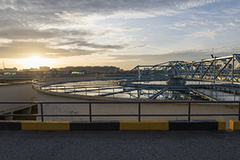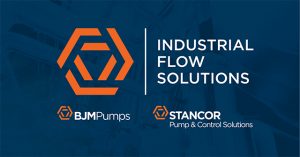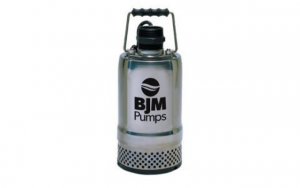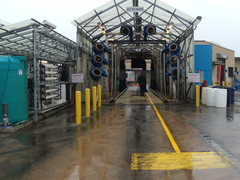Many water treatment plants extract fresh water from a nearby river. Pumping fresh water from a river almost always entails pumping in a significant amount of sand and silt into the facility with the fresh water. Sand and silt can cause significant damage to pumping equipment, making it a challenge to find pumps that will operate reliably in this type of application.
In 2014, Goforth Williamson Inc. was contacted by a major metropolitan water treatment plant that provides drinking water to over 4 million urban residents. The water treatment plant required a replacement pump after one of their clarifier sump pumps had become worn.
The clarifier is a settling basin that allows the sand and silt to be separated from the water, with the sand and silt settling to the bottom. The basin settles out the sand, silt, and mud that gets pumped in from the river and rakes it into a sump that is located under the clarifier. The submersible pump installed in that clarifier sump is responsible for pumping the sand, silt, and mud to a sludge digester.
The abrasive nature of the sludge had caused excessive wear to the non-clog submersible pump that had been pumping in the clarifier sump. When the water treatment plant’s in-house maintenance team pulled the non-clog submersible pump for inspection, they could quickly see that the pump was worn out. The impeller had been severely eroded, with impeller vanes at half the size of their original trim dimensions. With holes in the volute, and other visible signs of extreme degradation, the maintenance team decided to consider a different type of submersible pump for their highly abrasive pumping application.
They contacted Andy Bramlett at Goforth Williamson Inc. and explained their need for a submersible pump that was more resistant to abrasion. Bramlett immediately thought of a BJM Pump he typically recommended for mining applications. Since this specific application required a heavy duty submersible pump that could handle abrasive slurries, he decided to discuss the capabilities of a specific KZN Submersible Slurry Pump with the city’s water treatment plant manager.
Bramlett talked with the plant manager about the engineered design of the KZN55-230T, explaining the three most important features that make this submersible pump more resistant to abrasion.
1. Chrome Iron Agitator – made from abrasive resistant 28% chrome iron (600 Brinell, 57 Rockwell C), the KZN Submersible Slurry Pumps utilize a high-chrome agitator. The high-chrome agitator would be perfect for suspending the sand, silt, and mud so that it could be easily pumped from the clarifier sump to the sludge digester.
2. Chrome Iron Semi-Open Impeller – the KZN Series Submersible Slurry Pump is constructed with a semi-open impeller, making it ideal for handling sand, silt, and mud. The high-chrome semi-open impeller, which has been proven to pump slurries with concentrations of solids as high as 70% by weight, could easily pump the sludge without clogging.
3. Chrome Iron Wear Plate – to counter the effects of erosion, the KZN Series Submersible Slurry Pump has a replaceable 28% chrome iron wear plate on the suction side where erosion typically causes a loss of pump performance. The replaceable high-chrome wear plate helps to improve overall pump life by providing higher endurance for abrasive applications.
Bramlett discussed other features of the KZN pump that would provide the water treatment plant with longer pump life. The previous non-clog submersible pump in that clarifier sump had worked for only a couple years, and the water treatment plant maintenance manager wanted to install a submersible pump that would last longer. Bramlett explained:
· The KZN is engineered for Continuous Duty – Every KZN has a stainless steel shaft and shaft sleeve which reduces shaft wear from abrasive slurries. The pump volutes are cast from hardened ductile iron, which at 300 Brinell hardness, are twice as resistant to abrasives as standard ductile iron. The hardened ductile iron volutes are cast with extra thick walls at the point where the pumped slurry enters the discharge.
· The KZN is designed with Superior Motor Protection – The KZN Submersible Slurry Pumps are protected by double silicon carbide mechanical seals that are housed in a separate oil-filled seal chamber, and the heavy duty lip seal offers additional protection for the mechanical seals. The motor is further protected with Class H motor insulation, built in amperage (FLA) and temperature overload protection.
· The KZN has a Slim, Top Discharge Design – the KZN Series Submersible Slurry Pump has a top discharge design for easy installation; and because the clarifier sump was only 4 feet wide and 8 feet deep, it was important to select a pump that not only fit in the sump, but also had the ability to pump the sump pit down to within inches of the bottom. A side discharge pump without a cooling jacket must stay submerged to avoid overheating, leaving as much as 3 feet of un-pumped slurry, but the KZN could move almost all of the sludge out of the clarifier sump during operation.
· The KZN comes with a Seal Minder® Moisture Detection System – the Seal Minder® Moisture Detection System provides additional protection which would help the water treatment plant’s maintenance staff avoid pump problems. The Seal Minder® is a sensor probe inside the oil chamber that can provide an early warning to protect the pump motor. When the seal failure circuit, or moisture detection circuit, is properly connected to a control panel, it informs the pump operator that there is moisture within the oil chamber. This early warning enables the operator to schedule pump inspection and take necessary maintenance action.
After reviewing all the features of the KZN pump, the city approved the recommendation from Goforth Williamson Inc. The water treatment plant installed the KZN Submersible Slurry Pump in 2014 and the pump has operated reliably for the past two years. The pump has been operating so well in the clarifier sump that the water treatment plant has installed 3 more KZN pumps for three additional sumps.
Frac Sand Reclaimed From Sump Using KZN Submersible Slurry Pump




